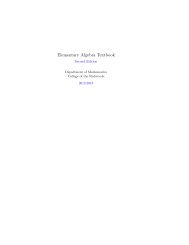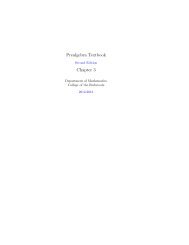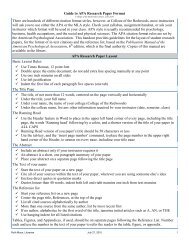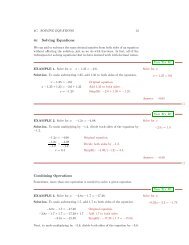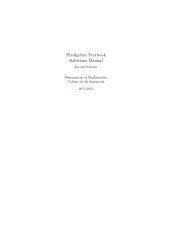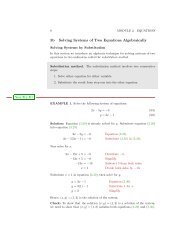Math 376 Prealgebra Textbook
Math 376 Prealgebra Textbook
Math 376 Prealgebra Textbook
Create successful ePaper yourself
Turn your PDF publications into a flip-book with our unique Google optimized e-Paper software.
1A. SOLVING EQUATIONS 3Equivalent Equations. Two equations are equivalent if they have the samesolution set.You Try It!EXAMPLE 2. Are the equations x − 3=6andx = 9 equivalent?Are the equations x =5andSolution. The number 9 is the only solution of the equation x − 3 = 6.x − 7 = 10 equivalent?Similarly, 9 is the only solution of the equation x =9. Thereforex − 3=6andx = 9 have the same solution sets and are equivalent. Answer: No.□Operations that Produce Equivalent EquationsWe now turn to operations that will produce equivalent equations.Adding the Same Quantity to Both Sides of an Equation. Adding thesame quantity to both sides of an equation does not change the solution set.That is, ifa = b,then adding c to both sides of the equation produces the equivalent equationa + c = b + c.Subtracting the Same Quantity from Both Sides of an Equation.Subtracting the same quantity to both sides of an equation does not changethe solution set. That is, ifa = b,then subtracting c from both sides of the equation produces the equivalentequationa − c = b − c.Wrap and UnwrapSuppose that you are wrapping a gift for your cousin. You perform the followingsteps in order.1. Put the gift paper on.2. Put the tape on.
4 MODULE 1. LINEAR EQUATIONS AND INEQUALITIES3. Put the decorative bow on.When we give the wrapped gift to our cousin, he politely unwraps the present,“undoing” each of our three steps in inverse order.1. Take off the decorative bow.2. Take off the tape.3. Take off the gift paper.This seemingly frivolous wrapping and unwrapping of a gift contains somedeeply powerful mathematical ideas.Consider the mathematical expression x + 4. To evaluate this expression ata particular value of x, we would start with the given value of x, then1. Add 4.Suppose we started with the number 7. If we add 4, we arrive at the followingresult: 11.Now, how would we “unwrap” this result to return to our original number?We would start with our result, then1. Subtract 4.That is, we would take our result from above, 11, then subtract 4, which returnsus to our original number, namely 7.Addition and Subtraction as Inverse Operations. Two extremely importantobservations:The inverse of addition is subtraction. If we start with a number x andadd a number a, then subtracting a from the result will return us to the originalnumber x. In symbols,x + a − a = x.The inverse of subtraction is addition. If we start with a number x andsubtract a number a, then adding a to the result will return us to the originalnumber x. In symbols,x − a + a = x.You Try It!Solve for x:EXAMPLE 3. Solve x − 7=12forx.x − 6=4
1A. SOLVING EQUATIONS 5Solution: To undo the effect of subtracting 7, we add 7 to both sides of theequation.x − 7=12x − 7+7=12+7x =19Original equation.Adding 7 to both sides of the equationproduces an equivalent equation.On the left, adding 7 “undoes” the effectof subtracting 7 and returns x. On the right,12 + 7 = 19.Therefore, the solution of the equation is 19.Check: To check, substitute the solution 19 into the original equation.x − 7=12Original equation.19 − 7=12 Substitute 19 for x.12 = 12 Simplify both sides.The fact that the last line of the check is a true statement guarantees that 19is a solution of x − 7=12. Answer: 10□In the solution of Example 3, we use the concept of the “inverse.” If we startwith x, subtract7,thenadd7,wearereturnedtothenumberx. In symbols,x − 7+7=x. We are returned to x because “subtracting 7” and “adding 7”are inverse operations of one another. That is, whatever one does, the other“undoes.”
6 MODULE 1. LINEAR EQUATIONS AND INEQUALITIESYou Try It!Solve for x:x + 1 2 = 3 5EXAMPLE 4. Solve x + 2 3 = 1 for x.2Solution: To undo the effect of adding 2/3, we subtract 2/3 from both sidesof the equation.x + 2 3 = 1 2x + 2 3 − 2 3 = 1 2 − 2 3Original equation.Subtracting 2/3 from both sidesproduces an equivalent equation.x = 3 6 − 4 6x = − 1 6Therefore, the solution of the equation is −1/6.On the left, subtracting 2/3 “undoes”the effect of adding 2/3 and returns x.On the right, make equivalent fractionswith a common denominator.3Subtract:6 − 4 6 = − 1 6□More Operations That Produce Equivalent EquationsHere are two more operations that produce equivalent equations.Multiplying Both Sides of an Equation by a Nonzero Quantity. Multiplyingboth sides of an equation by a nonzero quantity does not change thesolution set. That is, ifa = b,and c ≠ 0, then multiplying both sides of the equation by c produces theequivalent equationac = bc.Dividing Both Sides of an Equation by a Nonzero Quantity. Dividingboth sides of an equation by a nonzero quantity does not change the solutionset. That is, ifa = b,and c ≠ 0, then dividing both sides of the equation by c produces the equivalentequationac = b c .
1A. SOLVING EQUATIONS 7Like addition and subtraction, multiplication and division are inverse operations.Multiplication and Division as Inverse Operations. Two extremely importantobservations:The inverse of multiplication is division. If we start with a number xand multiply by a number a, then dividing the result by the number a returnsus to the original number x. In symbols,a · xa = x.The inverse of division is multiplication. If we start with a number x anddivide by a number a, then multiplying the result by the number a returns usto the original number x. In symbols,a · xa = x.EXAMPLE 5. Solve −2.1x =0.42 for x. Solve for x:You Try It!Solution: To undo the effect of multiplying by −2.1, we divide both sides ofthe equation by −2.1.−3.6x =0.072−2.1x =0.42−2.1x−2.1 = 0.42−2.1x = −2Original equation.Dividing both sides by −2.1produces an equivalent equation.On the left, dividing by −2.1 “undoes”theeffect of multiplying by −2.1 andreturnsx.On the right, divide: 0.42/(−2.1) = −2.Therefore, the solution of the equation is −2.Check: To check, substitute the solution −2 into the original equation.−2.1x =0.42−2.1(−2) = 0.42Original equation.Substitute −2 forx.0.42 = 0.42 On the left, multiply: −2.1(−2) = 0.42The fact that the last line of the check is a true statement guarantees that −2is a solution of −2.1x =0.42. Answer: −0.02□
8 MODULE 1. LINEAR EQUATIONS AND INEQUALITIESSolving Equations: Clearing Fractions and DecimalsIn this section we introduce techniques that clear fractions and decimals fromequations. When clearing fractions from an equation, you will need to simplifyproducts like the ones posed in the following examples.Example ?? shows all of the steps involved in arriving at the answer. Again,the goal in this section is to perform this calculation mentally, so we just“Divide 7 into 28 to get 4, then multiply 4 by 6 to get 24.”( ) 6287 x =24xNot only does this approach allow us to write down the answer without doingany work, the numerical calculations involve smaller numbers. You need topractice this mental calculation until you can write down the answer withoutwriting down any steps.You Try It!( ) 5EXAMPLE 6. Simplify: 279 x .Solution: Divide 9 into 27 to get 3, then multiply 3 by 5 to get 15.( ) 5279 x =15x□Simplify:Answer: 27x( ) 3182 xClearing FractionsNow that we’ve done the required fraction work, we can now concentrate onclearing fractions from an equation.Clearing fractions from an equation. To clear fractions from an equation,multiply both sides of the equation by the least common denominator.You Try It!EXAMPLE 7. Solve for x: x + 2 3 = 1 2 . Solve for x:x − 3 4 = 1 2
1A. SOLVING EQUATIONS 9Solution: The common denominator for 2/3 and 1/2 is 6. We begin bymultiplying both sides of the equation by 6.x + 2 3 = 1 (26 x + 2 ) ( ) 1=63 2( ( )2 16x +6 =63)2Original equation.Multiply both sides by 6.On the left, distribute the 6.To simplify 6(2/3), you have two choices. You can multiply 6 and 2 to get 12,then divide 12 by 3 to get 4. Or you can divide 3 into 6 to get 2, then multiply2 by 2 to get 4. Either way, 6(2/3) = 4. Similarly, 6(1/2) = 3.( ) ( 2 16x +4=3 Multiply: 6 =4,6 =3.3 2)Note that the fractions are now cleared from the equation. To isolate termscontaining x on one side of the equation, subtract 4 from both sides of theequation.6x +4− 4=3− 46x = −1Subtract 4 from both sides.Simplify both sides.To “undo” multiplying by 6, divide both sides by 6.6x6 = −16x = − 1 6Divide both sides by 6.Simplify both sides.□r x:− 3 7 x = 3 2EXAMPLE 8. Solve for x:45 x = − 4 3 .Solution: The common denominator for 4/5 and −4/3 is 15. We begin bymultiplying both sides of the equation by 15.You Try It!45 x = − 4 ( )3(4155 x =15 − 4 )3Original equation.Multiply both sides by 15.
10 MODULE 1. LINEAR EQUATIONS AND INEQUALITIESTo simplify 15(4/5), you have two choices. Multiply 15 and 4 to get 60, thendivide 60 by 5 to get 12. Or you can divide 5 into 15 to get 3, then multiply 3by 4 to get 12. Either way, 15(4/5) = 12. Similarly, 15(−4/3) = −2012x = −20Multiply.To “undo” multiplying by 12, we divide both sides by 12.12x12 = −2012x = − 5 3Divide both sides by 12.Reduce to lowest terms.Check: To check, substitute −5/3 forx in the original equation.45 x = − 4 (34− 5 )= − 4 5 3 3− 2015 = − 4 3− 4 3 = − 4 3Original equation.Substitute −5/3 forx.Multiply numerators and denominators.Reduce.The fact that the last line is a true statement guarantees the −5/3 is a solutionof the equation 4 5 x = − 4 3 . Answer: x = − 7 2□You Try It!EXAMPLE 9. Solve for x:2x3 − 3 4 = 1 2 − 3x 4 . Solve for x:Solution: The common denominator for 2x/3, −3/4, 1/2, and −3x/4 is 12.We begin by multiplying both sides of the equation by 12.( 2x1232x3 − 3 4 = 1 2 − 3x (42x123 − 3 ( 1=124)2 − 3x )4) ( 3− 12 =124)( ( )1 3x− 122)4Original equation.Multiply both sides by 12.Distribute the 12 on each side.5x9 − 2 3 = 5 9 − 3 2To simplify 12(2x/3), you have two choices. Multiply 12 by 2x to get 24x,then divide 24x by 3 to get 8x. Or you can divide 3 into 12 to get 4, then
1A. SOLVING EQUATIONS 11multiply 4 by 2x to get 8x. Either way, 12(2x/3) = 8x. Simlarly, 12(3/4) = 9,12(1/2) = 6, and 12(3x/4) = 9x.8x − 9=6− 9xMultiply.Note that the fractions are now cleared from the equation. We now need toisolate terms containing x on one side of the equation. To remove the term−9x from the right-hand side, add 9x to both sides of the equation.8x − 9+9x =6− 9x +9x17x − 9=6Add 9x to both sides.Simplify both sides.To remove the term −9 from the left-hand side, add 9 to both sides of theequation.17x − 9+9=6+917x =15Add 9 to both sides.Simplify both sides.Finally, to “undo” multiplying by 17, divide both sides of the equation by 17.17x17 = 157x = 1517Divide both sides by 17.Simplify both sides.□Clearing Decimals from an EquationMultiplying by the appropriate power of ten will clear the decimals from anequation. However, first note the following:• 10(1.2345) = 12.345.place to the right.Multiplying by 10 moves the decimal point one• 100(1.2345) = 123.45. Multiplying by 100 moves the decimal point twoplaces to the right.• 1000(1.2345) = 1234.5. Multiplying by 1000 moves the decimal pointthree places to the right.Note the pattern: The number of zeros in the power of ten determines thenumber of places to move the decimal point. So, for example, if we multiplyby 1,000,000, which has six zeros, this will move the decimal point six placesto the right.
12 MODULE 1. LINEAR EQUATIONS AND INEQUALITIESYou Try It!Solve for x:EXAMPLE 10. Solve for x:2.3x − 1.25 = 0.04x.1.34 − 4.5x =2.2 Solution: The first term of 2.3x − 1.25 = 0.04x has one decimal place, thesecond term has two decimal places, and the third and final term has twodecimal places. At a minimum, we need to move each decimal point two placesto the right in order to clear the decimals from the equation. Consequently, wemultiply both sides of the equation by 100.2.3x − 1.25 = 0.04x Original equation.100(2.3x − 1.25) = 100(0.04x) Multiply both sides by 100.100(2.3x) − 100(1.25) = 100(0.04x) Distribute the 100.230x − 125 = 4xMultiplying by 100 moves all decimalpoints two places to the right.Note that the decimals are now cleared from the equation. We must now isolateall terms containing x on one side of the equation. To remove the term 4x fromthe right-hand side, subtract 4x from both sides of the equation.230x − 125 − 4x =4x − 4x226x − 125 = 0Subtract 4x from both sides.Simplify.To remove −125 from the left-hand side, add 125 to both sides of the equation.226x − 125 + 125 = 0 + 125226x =125Add 125 to both sides.Simplify both sides.Finally, to “undo” multiplying by 226, divide both sides by 226.226x226 = 125226x = 125226Divide both sides by 226.Simplify.□



